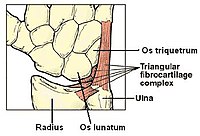
Photo from wikipedia
When evaluating the available literature on the diagnosis and management of triangular fibrocartilage complex tears (TFCC), ulnar tears comprise the major focus of TFCC literature. Radial-sided (Class 1D) tears are… Click to show full abstract
When evaluating the available literature on the diagnosis and management of triangular fibrocartilage complex tears (TFCC), ulnar tears comprise the major focus of TFCC literature. Radial-sided (Class 1D) tears are seldom researched or discussed. The purpose of this study was to review the methods for identifying and treating radial-sided TFCC lesions, by examining the anatomy of the TFCC, the pathology of its radial portion, diagnostic techniques, and both surgical and nonoperative treatments. The avascular nature of the radial TFCC may influence its healing potential. Magnetic resonance arthrogram is the gold standard for non-invasively diagnosing a radial-sided tear. Non-operative management should be exhausted prior to surgical intervention, which commonly involves an inside-out repair involving radial trans-osseous sutures. Still, the literature is limited by patient sample size and therefore requires a greater population of class 1-D tears to confirm optimal diagnostic and treatment methods.
Journal Title: Hand
Year Published: 2022
Link to full text (if available)
Share on Social Media: Sign Up to like & get
recommendations!